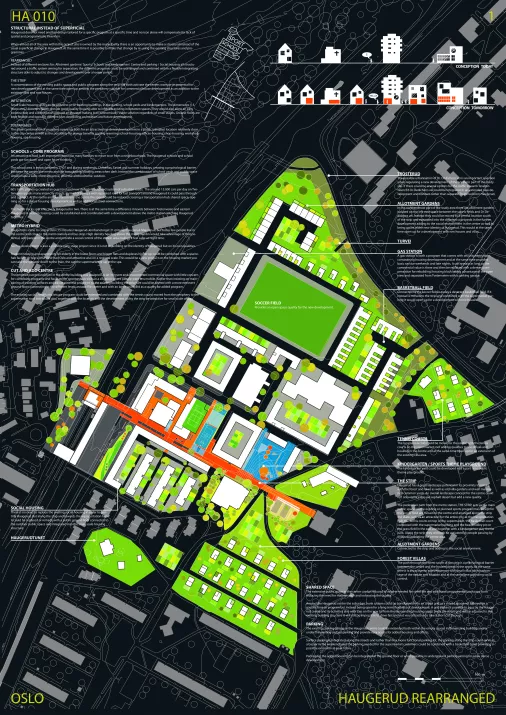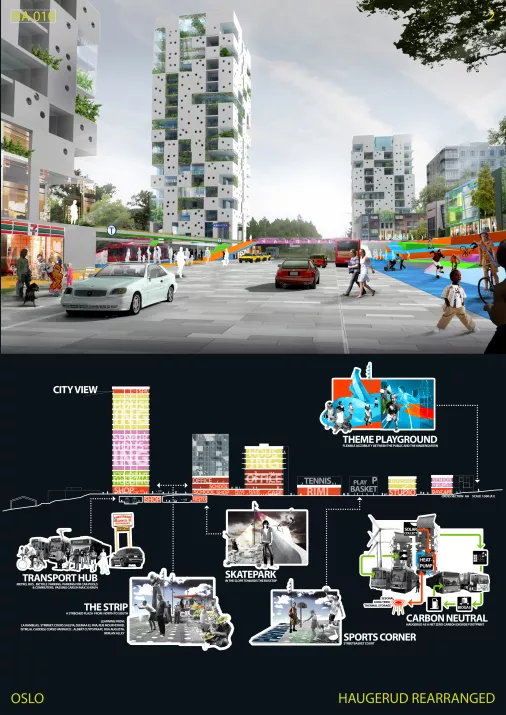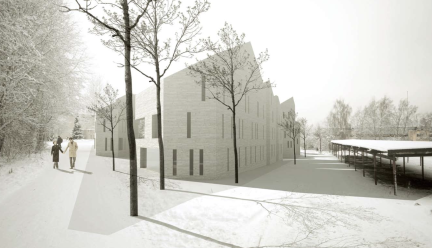Project:
Haugerud Rearranged
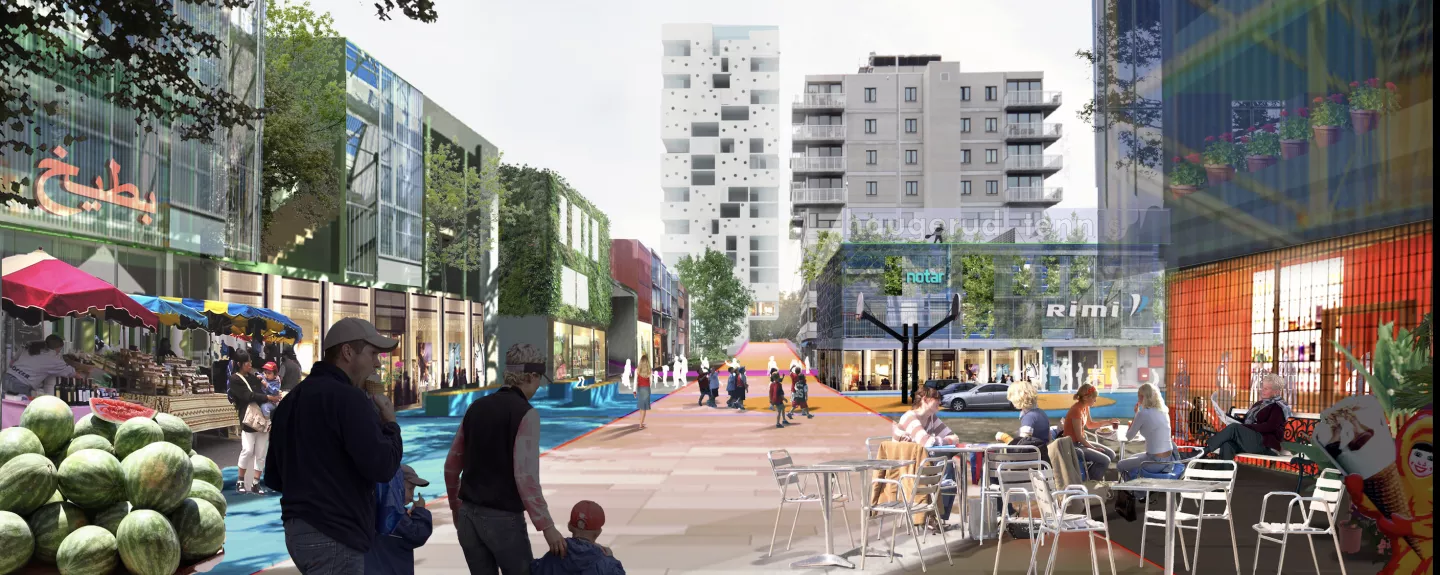
About
-
STRUCTURAL INSTEAD OF SUPERFICIAL
Haugerud does not need another design tailored for a specific programme at a specific time, and no icon alone will compensate for lack of spatial and programmatic invention. When almost all of the area within the project site is owned by the municipality, there is an opportunity to make a structural, instead of the usual superficial, change in Haugerud. At the same time, it is possible to make that change by re-using the existing structures and programmes.
REARRANGED
Instead of planning for different enclaves for allotment gardens, sports facilities, schools and kindergartens, a centre with parking and social housing, all structured around a traffic system aimed at separation, the different programmes could be rearranged and combined within a flexible integrating structure able to adjust to changes and development over a longer period.THE STRIP
A concentration of the existing public space and public programme along the strip will activate the centre, increasing its potential for new development, and open up areas in the periphery suitable for commercial house development as an addition to the existing villas and row houses.INFILTRATION
Small scale housing units can be added to, or on, existing buildings in the parking area, school yards and kindergartens. The dimensions 1-3 floors and 7-8 metres depth provide good quality housing able to infiltrate existing in-between spaces. They would also allow for easy construction and a distribution without an elevator, making it an economically viable solution regardless of the small stages. Ground floors are kept flexible and open for different uses depending on location and potential future development.SUSTAINABLE
The close combination of programmes opens up, creating an attractive low dense development in a public transport location relatively close to the city centre, as well as the possibility for energy benefits by combining the school, offices, shops, workshop, and spa with housing.SCHOOLS CORE PROGRAM
An attractive school is an important reason for many families to move to a neighbourhood. The Haugerud schools and school yards are run down and in need of re-thinking.
The school area is empty between 17-07, during weekends, Christmas, Easter and summer holidays; this creates a psychological barrier between the centre, the metro and the surrounding housing areas when dark. The combination of school yards and public space would make a safer, more attractive, effective and economic solution.TRANSPORTATION HUB
Sixties traffic planning created an oversized, and now definitely outdated system of suburban roads. The roughly 15,000 cars per day on Tvetenveien can match the numbers of many inner city streets. Instead of being a separated road for fast transport around Haugerud, it could pass through and connect. At the metro station, bus stop, and the centre the speed could be reduced while crossing a transportation hub shared space, creating potential for a dense housing development as well as additional street connections.
The metro tracks have effectively split Haugerud in two. There is at the same time a difference in levels between Tvetenveien and eastern Haugerud. A second crossing could be established and coordinated with a development above the metro station, stitching Haugerud together.METRO HYBRID
Haugerud is close to central Oslo (15 minutes Haugerud- Jernbanetorget, 21 minutes Haugerud-Majorstua), but today few people live in the centre close to the metro station and bus stop. High density housing above the metro station would take advantage of that potential by adding people in the centre, and providing social control of the station area making it feel safer at night time.
Such a development is also a possible early stage project since it is not dependent on the identity of Haugerud, but on its own qualities.
Student housing and apartments for elderly in the lower floors, with bigger flats and duplexes higher up, could be combined with a spa/rehab facility on top with a view over Oslo, making it attractive also on a regional scale. This would be a new product on the housing market; you can take the elevator down to the train, car, or supermarket, and up to the spa.CUT AND ADD CENTRE
The emptied out ground floor in the centre building was designed as an introvert and disconnected commercial space with little concern for combining programmes and facilitating spontaneous visits in a situation where people were less mobile. Rather than insisting on maintaining all existing surfaces and adjusting potential programmes to the existing building, the structure could be altered with more extrovert ground floors, connecting to the different levels around the centre with an inner courtyard for added programme.
The existing social, health and leisure programme could be extended and combined with the tennis courts moved from the periphery to the supermarket roof; this would also, together with the location and the development along the strip, be attractive for small scale offices.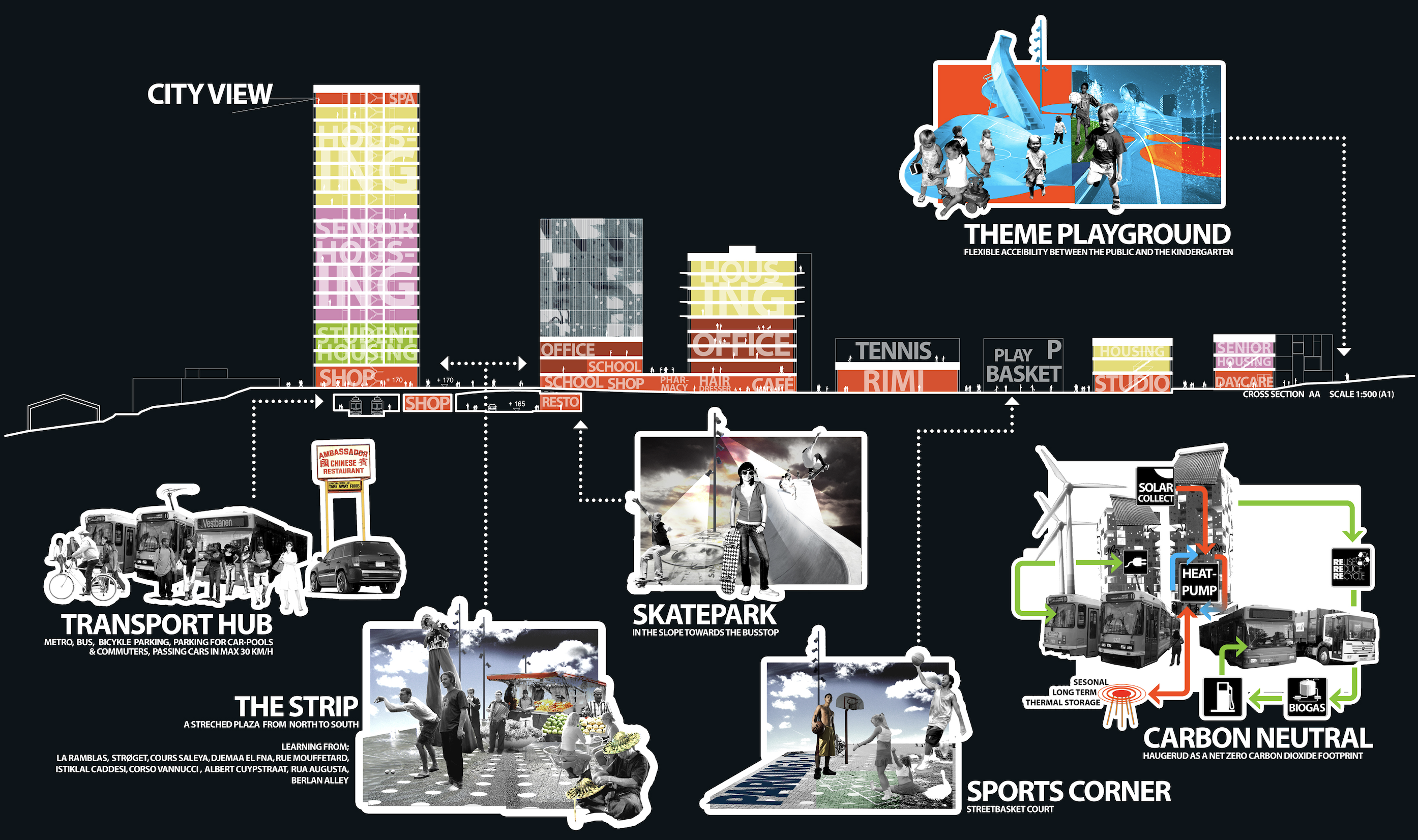
-
This proposal argues for a densification of Haugerud with the goal of growing it into a hub. The competitor extends the competition site for the building propos- al, suggesting the development of an urban concept both parallel and perpendic- ular to the metro line in the form of a pedestrian strip. New buildings and public spaces are proposed with different programmes to support ‘the strip’, (the proj- ect’s main organisational structure.) “Haugerud Rrearranged” carries several positive aspects aimed at providing the area with a more distinct urban charac- ter. The plan shows a robust character that allows for many actors to be involved over a long period of time. The well-drawn plan integrates parts of the existing structures in a convincing manner, and the band of sport programmes is com- bined well with the public pedestrian street.
Even so, the jury doubts that Haugerud should strive to enforce its hub qualities, as there are already other, better developed hubs in the neighbouring area (such as Tveita). The strength of this entry is the plan, not the architecture. The build- ings lack innovation, and the architectural illustrations are feeble (especially the tall buildings). We doubt that Haugerud’s problems will be solved by an updated repetition of a grand modernist plan that implements more of the same type of buildings.
-
Björn Bondesson
Thomas Landenberg
Jenny Mäki
Mikael Stenqvist
Sofia PalmerContact information:
thomas.landenberg@white.seThe team constitutes an interdisciplinary constellation based in Stockholm and Göteborg. They combine their different experiences and backgrounds from studying or working in Sweden, Norway, France, Holland and Peru. Together they are doing urban projects in different constellations with conceptual approach, exploring the potential of landscape and infrastructure to generate context specific development and add qualities to neighborhoods and housing typologies.
